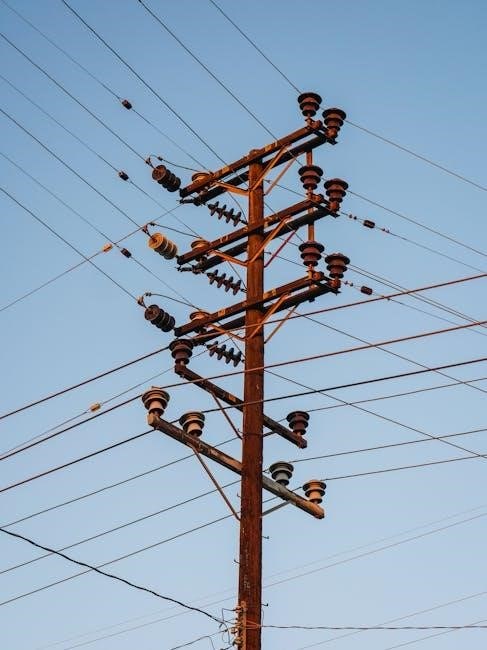
manual power pole for boat
Manual power poles are essential for shallow water boating, providing stability and control. They allow quick anchoring in shallow waters, preventing drift and maintaining position. A cost-effective alternative to automatic systems, ideal for anglers seeking precise control.
1.1 What is a Manual Power Pole?
A manual power pole is a shallow water anchoring system designed to stabilize boats in shallow waters. It consists of a telescoping pole that can be manually deployed into the seabed. Unlike automatic systems, manual power poles rely on physical operation, often using a handle or lever to push the pole into the ground. This setup provides a silent and efficient way to anchor, making it ideal for fishing and other activities where noise and precision are critical. The simplicity of manual power poles makes them a cost-effective solution for boat stability in shallow environments.
1.2 Importance of a Manual Power Pole for Boat Stability
A manual power pole is essential for maintaining boat stability in shallow waters. It prevents the boat from drifting due to currents or wind, ensuring precise control. This stability is crucial for fishing, as it allows anglers to focus on their targets without losing position. The pole’s ability to anchor quietly minimizes disturbance to marine life, making it an ideal choice for stealthy fishing operations. Additionally, it provides a cost-effective and durable solution for boat stabilization, enhancing overall boating efficiency and safety in shallow water environments.
Key Features of a Manual Power Pole
A manual power pole is known for its durability and adjustable length, making it suitable for various shallow water conditions. Its simple yet robust design ensures ease of use and long-lasting performance, enhancing boating efficiency.
2.1 Material and Construction
Manual power poles are typically crafted from durable materials like aluminum or fiberglass, ensuring strength and resistance to corrosion. The construction often features a hollow, lightweight design for easy handling while maintaining rigidity. Many poles include a rust-resistant coating to withstand marine environments. The adjustable sections are securely locked in place, providing stability and reliability. High-quality materials ensure the pole withstands harsh conditions, making it a reliable choice for shallow water anchoring. This robust construction maximizes durability and performance, ideal for frequent use in various aquatic settings.

2.2 Adjustable Length and Durability
Manual power poles are designed with adjustable lengths to suit various shallow water conditions. This feature allows boaters to customize deployment based on water depth and stability needs. Constructed from heavy-duty materials, these poles offer exceptional durability, resisting wear from frequent use and harsh marine environments. The adjustable mechanism ensures secure locking at desired lengths, preventing slippage. This combination of adaptability and robust construction makes manual power poles a reliable and long-lasting solution for anchoring in shallow waters, enhancing overall boating efficiency and safety.

Installation Guide for a Manual Power Pole
Installing a manual power pole involves gathering necessary tools, following manufacturer instructions, ensuring proper alignment, and securing the pole. Testing post-installation is crucial for functionality.
3.1 Step-by-Step Installation Process
Start by gathering tools and hardware, including bolts and a wrench. Mount the base on the boat’s transom, ensuring proper alignment. Tighten bolts securely. Next, attach the pole to the base, following the manufacturer’s instructions. Test the pole’s stability by applying gentle pressure. Finally, inspect all connections and ensure the pole is fully functional before use.
Using a Manual Power Pole Effectively
Deploy the pole in clear water at a 45-degree angle, then adjust its length for optimal stability. Retrieve smoothly to avoid damage or disruption.
4.1 Deploying the Pole
Deploying a manual power pole requires careful technique to ensure stability and effectiveness. Begin by locating a stable bottom in shallow waters, avoiding soft mud or debris. Slowly lower the pole at a 45-degree angle until it contacts the ground. Use your weight to drive it firmly into the sediment. Ensure the pole is vertical and secure to maintain balance. For optimal results, deploy in calm conditions and avoid rocky or uneven surfaces that could cause damage. This method provides a silent and reliable anchoring solution.
4.2 Adjusting the Pole for Optimal Stability
Adjusting the manual power pole is crucial for maintaining optimal stability in varying water conditions. Begin by tweaking the pole’s length to ensure it reaches the bottom firmly without over-extending. Angle adjustments should be made to counteract wind or current, keeping the boat steady; Use the boat’s position as feedback, making incremental changes until balance is achieved. Secure the pole tightly to prevent shifting. Regularly monitor and adjust the pole’s position to adapt to changing environmental factors, ensuring maximum stability and control throughout your fishing or boating experience.
4.3 Retrieving the Pole After Use
Retrieving the manual power pole after use is straightforward but requires care. First, ensure the pole is fully disengaged from the water and any tethering lines are released. Pull the pole upward smoothly, avoiding sudden jerks to prevent damage. Once retrieved, rinse the pole with fresh water to remove dirt or debris. Store it securely in its designated mount or bracket to prevent movement during transit. Regular inspection after retrieval helps identify wear or damage, ensuring longevity and optimal performance in future use.

Maintenance and Care Tips
Regularly clean the manual power pole with mild detergent and freshwater to prevent corrosion. Store it in a dry, secure location to avoid damage and extend lifespan.
5.1 Cleaning and Storage
Regular cleaning is crucial for maintaining your manual power pole. Use mild detergent and freshwater to rinse off dirt and salt residue, ensuring no corrosion forms. After cleaning, thoroughly dry the pole to prevent moisture damage. Store the pole in a secure, dry location, away from direct sunlight and extreme temperatures. Consider using a protective cover to shield it from dust and debris. Proper storage and cleaning routines will extend the lifespan and performance of your manual power pole, ensuring reliability when you need it most.
5.2 Troubleshooting Common Issues
Common issues with manual power poles often stem from corrosion or mechanical wear. If the pole fails to deploy, check for debris or rust in the mechanism. Lubricate moving parts regularly to ensure smooth operation. If the pole sticks, gently clean and apply a marine-grade lubricant. For broken or bent sections, replace them promptly to avoid further damage. Addressing these issues early prevents costly repairs and ensures reliable performance. Always refer to the manufacturer’s guidelines for specific troubleshooting steps tailored to your model.

Cost and Value Consideration
Manual power poles are cost-effective, with prices ranging from $300 to $1,200, offering durability and functionality for shallow water boating needs, making them a practical investment.
6.1 Price Range of Manual Power Poles
Manual power poles for boats typically range in price from $300 to $1,200, depending on the brand, quality, and length. Basic models with shorter lengths (5-6 feet) are more affordable, while longer poles (8-10 feet) or those made from premium materials cost more. The price often includes the pole, mounting hardware, and basic instructions. While manual power poles are generally cheaper than automatic ones, they still offer excellent durability and functionality, making them a cost-effective solution for shallow water anchoring needs.
6.2 Is a Manual Power Pole Worth the Investment?
A manual power pole is a worthwhile investment for boat owners, especially those who frequent shallow waters. It offers cost-effectiveness, simplicity, and reliability, making it ideal for anglers seeking precise control. While it requires manual effort, the benefits of silent operation, durability, and ease of maintenance often outweigh the drawbacks. Many users report high satisfaction, as it enhances fishing efficiency and boat stability. For those prioritizing performance without the premium cost of automatic systems, a manual power pole is a practical and effective choice.
Manual vs. Automatic Power Poles
Manual power poles offer cost-effectiveness and simplicity, while automatic poles provide convenience and speed. Manual poles are ideal for shallow waters and require less maintenance, whereas automatic poles suit deeper waters and offer remote control functionality, making them more versatile but pricier. The choice depends on user preference, budget, and specific boating needs.
7.1 Pros and Cons of Manual Power Poles
Manual power poles are cost-effective and easy to install, making them a practical choice for shallow water boating. They require minimal maintenance and are highly durable, suitable for anglers seeking simplicity. However, they lack the convenience of automation, requiring manual deployment and adjustment. While they excel in shallow waters, they may not perform as well in deeper conditions. Despite these limitations, manual power poles remain a reliable and budget-friendly option for many boaters, offering a straightforward solution for stability and control in specific fishing environments.
7.2 Comparison with Automatic Power Poles
Automatic power poles offer greater convenience with remote control and faster deployment, making them ideal for deep water use; However, they are more expensive and require regular maintenance of electrical and hydraulic systems. Manual power poles, while lacking automation, are cost-effective, easier to install, and more reliable in shallow waters. They suit anglers prioritizing simplicity and budget, whereas automatic poles cater to those needing advanced features and ease of use, despite higher costs and maintenance demands.

Safety Tips for Using a Manual Power Pole
Always wear protective gear and ensure the area is clear before deploying. Avoid raising or lowering the pole near power lines or overhead obstacles to prevent accidents. Regularly inspect the pole for damage or corrosion to maintain reliability and safety while in use.
8.1 Essential Safety Precautions
When using a manual power pole, always wear protective gear and ensure the area is clear. Avoid deploying near power lines or overhead obstacles. Regularly inspect the pole for damage or corrosion to prevent failure. Ensure proper mounting and secure the pole when not in use. Be cautious of changing water conditions and never overload the pole. Keep emergency tools nearby and educate all onboard on proper usage. Following these precautions enhances safety and ensures reliable performance during boating adventures.

Real-Life Applications and Case Studies
Anglers in shallow waters rely on manual power poles for stability, while small boat users like kayaks employ them for silent, precise anchoring in sensitive fishing environments.
9.1 Successful Use of Manual Power Poles in Shallow Waters
Manual power poles have proven indispensable in shallow water environments, offering anglers and boaters a reliable means of maintaining position without damaging ecosystems. Their silent operation prevents startling fish, making them ideal for fishing applications. Many users report success in waters as shallow as 12 inches, where traditional anchors fail. Small boat owners, including kayakers and canoeists, appreciate their portability and ease of use. These poles are particularly effective in sensitive habitats, ensuring minimal environmental impact while providing stability. Their popularity continues to grow among those seeking a practical, cost-effective anchoring solution for shallow water adventures.

Manual power poles are a practical investment for boaters, offering reliability in shallow waters. Their silent operation and durability make them ideal for anglers. A cost-effective solution for stability and control, they are a must-have for small boat owners seeking to enhance their boating experience while minimizing environmental impact.
10.1 Summary of Benefits and Considerations
Manual power poles offer enhanced stability and control for boats in shallow waters, making them ideal for anglers and small watercraft. Their portability and ease of use provide a practical solution for anchoring without the need for complex systems. Key benefits include silent operation, durability, and cost-effectiveness. However, manual operation requires physical effort, and users must consider water depth and soil conditions for effective use. Overall, they are a reliable choice for boaters seeking a simple, efficient anchoring solution in shallow environments.